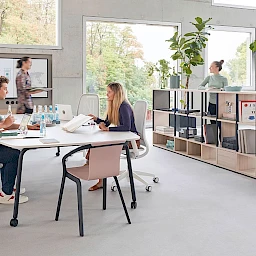Hybrid work is facing companies with new challenges. We spoke with Professor Johanna Bath from the ESB Business School in Reutlingen about how well-functioning hybrid work should be organised.
Dr Bath, how is the world of work changing?
For one thing, demographic development means that fewer specialized workers will be available in the future. For another, people’s attitude toward work itself has changed. Today many people no longer want to work full-time. They are more likely than before to balance the required effort against the returns. On the other hand, because of digitalization it’s relatively easy to support or replace work activities through automation technology. These two drivers are closely interlinked, and companies need to find a good way to deal with them.
How can hybrid work be successful, and how should the organisation of work be structured?
I’ve developed a maturity model called the Hybrid Work Assessment. Companies can use it to find out what’s good about their hybrid work model and what is in need of improvement. The model takes four dimensions into account: leadership and strategy, communication and knowledge management, relationships within and beyond the team, and infrastructure. In the last of these dimensions, the focus is on what kind of equipment the office workers need in their digital workplace etc. And of course it’s also about the question of which processes must be changed or restructured in order to meet the requirements of the hybrid work environment.
Please also read

How does the corporate culture need to change as well?
I’m not a big fan of asking how people need to change their culture. I believe that a company first has to understand exactly what kind of company it is. Next, it has to form a coherent overall picture on the basis of what it has and what it is. The solution can’t be to change the corporate culture come hell or high water in order to create a certain image you’d like to have for whatever reasons. In my opinion, it’s more productive to ask questions such as: Who are we right now? What do we stand for right now? How can our work model support us in our present status? How can we find a suitable form of cooperation for this task? After we’ve answered these questions, the situation will become clearer for the employees. After all, not everyone is striving for a maximum degree of freedom. There are employee groups that are very clearly saying, “I’d like to go to the office five days a week.” And there are also companies in which the physical presence of their employees is such an important factor that focusing on physical attendance is a recipe for success. I even warn people against saying that there is an ideal type of workplace organisation that all companies should strive to achieve. Instead, we say that there are various archetypes that companies can strive towards, and they have to see whether the organisation as a whole is then systematically oriented towards the archetype they choose. As long as this effort succeeds, there are no limits to one’s inventiveness regarding how to design hybrid work. For example, if you say, “We have a work culture that emphasises physical presence, and we want most of our employees to work in the office,” but you’re doing nothing to make the physical infrastructure attractive at this location, then you don’t have a coherent concept within the archetype. Instead, the question is: Am I making it easy for my employees to live with the work model that is right for our organisation?
What do you make of the fact that big companies are once again requiring their employees to work in the office three days a week?
My attitude is relatively neutral, because every company has to make its own decisions. I only believe that if requiring employees’ physical presence is a stand-alone measure, it isn’t productive. Of course this requirement means that employees will come to the office somewhat more often. But the indirect factors, such as relationship management, communication, career development, the transfer of know-how, leadership etc. don’t automatically improve as a result of physical presence, and they also don’t develop by means of quotas. Instead, as a result of investigations we’re seeing that employees in companies that use quotas often produce a negative Employer Net Promoter Score. In other words, they wouldn’t recommend the company as an employer to other people. We’re also seeing that employees in companies without such quotas have a positive opinion of their employer significantly more often. In my opinion, this is a clear signal indicating that a company should use a different approach to requiring an attendance rate. This does not mean that increasing the quota of physical attendance can’t be very positive in certain important respects. But I in this case think it’s ineffective to use a blanket approach that obliges employees to be in the office three days a week.
How is the “new normal” affecting the real estate market and office utilisation?
We’re noticing that office utilisation is decreasing and that fluctuations in the use of office capacity are increasing. That makes planning more difficult for property operators, whether they are third-party operators or corporate real estate departments. However, the current situation is also an opportunity to deal more creatively with the spaces that exist. For example, it’s an opportunity to think about whether existing spaces can be repurposed for public use, whether co-working spaces can be installed as areas for absorbing overflow or offered to start-ups/students, or whether the existing infrastructure can be shared with other companies. The interesting aspect of this situation is that we’re seeing that positive encounters in the workplace, no matter with whom, boost productivity, innovation and loyalty to the company. In other words, if I just have a chat with someone waiting in a queue for coffee, someone who doesn’t even work in my company, but it’s a great and inspiring conversation with that person, this encourages me in my own work. As a result, businesses should definitely think about how they can liven up their premises, how they can create encounters, and how they can make sure that the existing infrastructure can be used well even beyond the boundaries of their own company.
Let’s think about work a bit more. How will the office look in the year 2050?
I think the whole topic of employees’ presence in the office will be much more fluid than it is today, and that hybrid technologies will be much more strongly represented in the office as a result. The preference for synchronous communication and physical presence that we have been trained to accept will decrease compared to digital presence and digital non-synchronous presence. We will come into contact with other people much more often via wearables at the touch of a button. That’s why I believe that in the office of 2050 there will also be communication via holograms, wearable devices, VR and AR, and that it will be normal for employees to join physical meetings digitally — in other words, in a virtual environment, almost as though they were physically present in the room.
Dr Bath, thank you for talking with us.
Dr Johanna Bath is a professor at the ESB Business School and has spent years researching trends in the world of work. She is in demand as an expert on the topics of hybrid work and hybrid leadership. As a speaker, a Top Voice at LinkedIn and a member of supervisory boards, she founded the hybrid work consultancy “Talen Tista now” at the beginning of 2023. The consultancy supports companies in a structured and data-based manner as they move towards a functioning hybrid work organization. Further information is available at https://talentistanow.de/ and at https://talentistanow.de/new-work-times-magazin/.
Cover photo: talentista now






